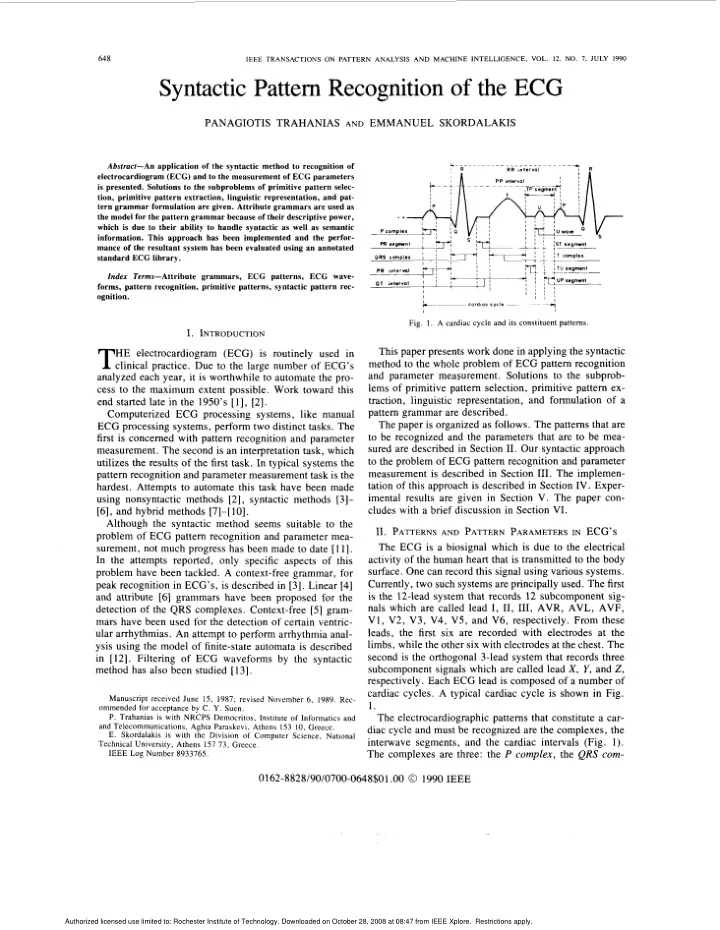

IEEE zyxwvutsrqponmlkjihgfedcbaZYXWVUTSRQPONMLKJIHGFEDCBA TRANSACTIONS ON PATTERN ANALYSIS AND MACHINE INTELLIGENCE, VOL. 12, NO. 7. JULY 1990 8 64 Syntactic Pattern Recognition of the ECG PANAGIOTIS TRAHANIAS AND EMMANUEL SKORDALAKIS Abstract-An application of the syntactic method to recognition of standard ECG library. zyxwvutsrqponmlkjihgfedcbaZYXWVUTSRQPONMLKJIHGFEDCBA electrocardiogram (ECG) and to the measurement of ECG parameters is presented. Solutions to the subproblems of primitive pattern selec- tion, primitive pattern extraction, linguistic representation, and pat- zyxwvutsrqponmlkjihgfedcbaZYXWVUTSRQPONMLKJIHGFEDCBA tern grammar formulation are given. Attribute grammars are used as the model for the pattern grammar because of their descriptive power, I T U zyxwvutsrqponmlkjihgfedcbaZYXWVUTSRQPONMLKJIHGFEDCBA which is due to their ability to handle syntactic as well as semantic information. This approach has been implemented and the perfor- mance of the resultant system has been evaluated using an annotated I zyxwvutsrqponmlkjihgfedcbaZYXWVUTSRQPONMLKJIHGFEDCBA ; segment r + - - - Index Terms-Attribute grammars, ECG patterns, ECG wave- i ~nt*rral forms, pattern recognition, primitive patterns, syntactic pattern rec- ~ ognition. I I--- cardlac cycle ~~~ I ~ I I Fig. 1, A cardiac cycle and its constituent patterns. I. INTRODUCTION T This paper presents work done in applying the syntactic HE electrocardiogram (ECG) is routinely used in method to the whole problem of ECG pattern recognition clinical practice. Due to the large number of ECG's and parameter meaSurement. Solutions to the subprob- analyzed each year, it is worthwhile to automate the pro- lems of primitive pattern selection, primitive pattern ex- cess to the maximum extent possible. Work toward this end started late in the 1950's [l], [ 2 ] . traction, linguistic representation, and formulation of a pattern grammar are described. Computerized ECG processing systems, like manual The paper is organized as follows. The patterns that are ECG processing systems, perform two distinct tasks. The to be recognized and the parameters that are to be mea- first is concerned with pattern recognition and parameter sured are described in Section 11. Our syntactic approach measurement. The second is an interpretation task, which to the problem of ECG pattern recognition and parameter utilizes the results of the first task. In typical systems the measurement is described in Section 111. The implemen- pattern recognition and parameter measurement task is the tation of this approach is described in Section IV. Exper- hardest. Attempts to automate this task have been made imental results are given in Section V. The paper con- using nonsyntactic methods [2], syntactic methods 131- cludes with a brief discussion in Section VI. [6], and hybrid methods [7]-[ 101. Although the syntactic method seems suitable to the 11. PATTERNS AND PATTERN PARAMETERS IN ECG's problem of ECG pattern recognition and parameter mea- The ECG is a biosignal which is due to the electrical surement, not much progress has been made to date [ l l]. activity of the human heart that is transmitted to the body Y, and zyxwvutsrqponmlkjihgfedcbaZYXWVUTSRQPONMLKJIHGFEDCBA In the attempts reported, only specific aspects of this surface. One can record this signal using various systems. subcomponent signals which are called lead X, zyxwvutsrqponmlkjihgfedcbaZYXWVUTSRQPONMLKJIHGFEDCBA problem have been tackled. A context-free grammar, for Currently, two such systems are principally used. The first peak recognition in ECG's, is described in [3]. Linear [4] is the 12-lead system that records 12 subcomponent sig- and attribute [6] grammars have been proposed for the detection of the QRS complexes. Context-free [5] gram- nals which are called lead I, 11, 111, AVR, AVL, AVF, V1, V2, V3, V4, V5, and V6, respectively. From these mars have been used for the detection of certain ventric- leads, the first six are recorded with electrodes at the ular arrhythmias. An attempt to perform arrhythmia anal- limbs, while the other six with electrodes at the chest. The ysis using the model of finite-state automata is described in [12]. Filtering of ECG waveforms by the syntactic second is the orthogonal 3-lead system that records three 2, method has also been studied [13]. respectively. Each ECG lead is composed of a number of .OO zyxwvutsrqponmlkjihgfedcbaZYXWVUTSRQPONMLKJIHGFEDCBA cardiac cycles. A typical cardiac cycle is shown in Fig. Manuscript received June 15, 1987; revised November 6, 1989. Rec- 1. ommended for acceptance by C. Y. Suen. P. Trahanias is with NRCPS Democritos, Institute of Informatics and The electrocardiographic patterns that constitute a car- and Telecommunications, Aghia Paraskevi, Athens 153 10, Greece. diac cycle and must be recognized are the complexes, the E. Skordalakis is with the Division of Computer Science, National interwave segments, and the cardiac intervals (Fig. 1). Technical University, Athens 157 73, Greece. The complexes are three: the P complex, the QRS com- IEEE Log Number 8933765. 6 3 1990 IEEE 0162-8828/90/0700-0648$01 Authorized licensed use limited to: Rochester Institute of Technology. Downloaded on October 28, 2008 at 08:47 from IEEE Xplore. Restrictions apply.
Recommend
More recommend